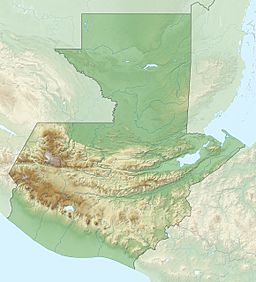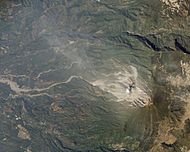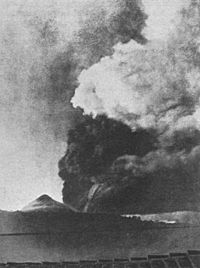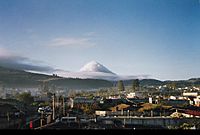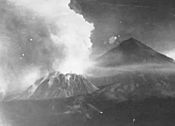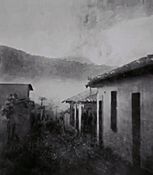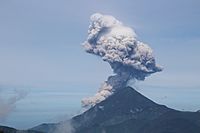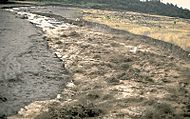Santa María (volcano) facts for kids
Quick facts for kids Santa María, Santiaguito |
|
|---|---|
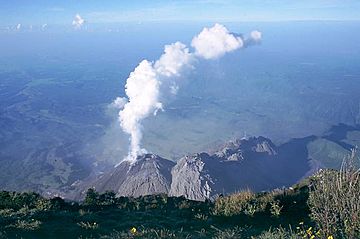
Santiaguito side cone from the summit of Santa María
|
|
| Highest point | |
| Elevation | 3,772 m (12,375 ft) |
| Geography | |
| Location | Quetzaltenango Department, Guatemala |
| Parent range | Sierra Madre |
| Geology | |
| Mountain type | Stratovolcano |
| Volcanic arc/belt | Central America Volcanic Arc |
| Last eruption | 2013 to present |
Santa María Volcano is a huge active volcano in the western highlands of Guatemala. It is found in the Quetzaltenango Department, close to the city of Quetzaltenango.
Long ago, before the Spanish arrived in the 1500s, local people called the volcano Gagxanul. This name means "Naked Volcano or Mountain" in the Kʼicheʼ language.
In 1902, Santa María Volcano had a massive eruption. It was one of the biggest eruptions of the 20th century! Only the 1912 Novarupta and 1991 Mount Pinatubo eruptions were larger. This eruption was also one of the five biggest in the last 200 to 300 years.
Contents
How Santa María Volcano Formed
Santa María Volcano is part of the Sierra Madre mountain range. This range stretches along the western side of Guatemala. These volcanoes formed because the Cocos Plate (a huge piece of Earth's crust) is slowly sliding under the Caribbean Plate. This process is called subduction. It created the Central America Volcanic Arc, which is a chain of volcanoes.
Scientists believe Santa María started erupting around 103,000 years ago. The volcano grew in four main stages, building up its large cone. This cone now stands about 1,400 meters (4,600 feet) above the flat land where Quetzaltenango city is located. After the main cone was built, the volcano's activity changed. It would be quiet for long periods, then release small lava flows from openings on its sides.
The Huge 1902 Eruption
The first time Santa María erupted that people recorded was in October 1902. Before this, the volcano had been sleeping for at least 500 years, maybe even thousands! But it started to wake up in January 1902. Many small earthquakes shook the area. There was even a very strong earthquake in April 1902.
The eruption began on October 24. The biggest explosions happened over the next two days. The volcano shot out about 8 cubic kilometers (2 cubic miles) of magma. This was one of the largest eruptions of the 20th century. It was almost as big as the Mount Pinatubo eruption in 1991. Scientists rate its power using the Volcanic Explosivity Index (VEI), and Santa María's 1902 eruption was a VEI 6, which is called 'Colossal'.
Light, bubbly rocks called pumice fell over a huge area, about 273,000 square kilometers (105,000 square miles). Volcanic ash even reached as far as San Francisco, California, which is 4,000 kilometers (2,500 miles) away! The eruption happened from an opening on the volcano's southwest side. It left a crater about 1 kilometer (0.6 miles) wide and 300 meters (980 feet) deep.
Because Santa María hadn't erupted in so long, local people didn't know the earthquakes were a warning. Sadly, about 6,000 people died because of the eruption.
During this terrible disaster, the local leaders in Quetzaltenango had to take charge. The main government was busy celebrating a big festival. They even tried to make the eruption seem less serious. They told people it wasn't even in Guatemala, but in México! The government also said they had no money to help, as funds were used for the April earthquake. So, the local leaders announced that all the crops in the western area were ruined. They predicted there would be a shortage of food. Animals were dying, so there was also a shortage of meat. The government finally allowed them to bring in flour without taxes for a few months.
For the native people, the eruption was truly awful. They lost family, friends, homes, and crops. On top of that, they were forced to work for free to help with the recovery. Meanwhile, wealthy landowners were given land that was taken from native communities in other areas.
What Happened During the 1902 Eruption
- October 24, 5:00 pm: In San Felipe, people heard a sound like a roaring waterfall coming from the volcano for five minutes. But thick mist hid the volcano.
- October 24, 6:00 pm: Small bits of ash and cinders began to fall over Quetzaltenango.
- October 24, 7:00 pm: People saw lightning and a bright red light from the volcano. They heard a noise like a huge furnace.
- October 24, 8:00 pm: From San Felipe, a giant cloud of black ash was visible. It had many swirling parts, thousands of lightning bolts, and curved red lights. The ground around the volcano kept shaking. Loud explosions could be heard 160 kilometers (100 miles) away! Strong winds carried ash and debris 800 kilometers (500 miles) or more. A part of the ash cloud stayed over the volcano for days, making everything pitch black.
- October 25, 1:00 am: The eruption became even more violent. Large rocks from the volcano started falling as far as 14 kilometers (9 miles) away, destroying towns and farmhouses.
- October 26, 12:00 am: The volcano became quiet.
- October 26, 3:00 pm: Another eruption happened, but this time a white cloud came out. This was probably mostly water vapor.
=Images for kids
Santiaguito: The New Volcano Inside
After the huge 1902 eruption, Santa María was quiet for 20 years. But in 1922, new eruptions began! A new lava dome started growing inside the crater left by the 1902 explosion. This new lava dome is called Santiaguito, and it's still active today! Over 1 cubic kilometer (0.24 cubic miles) of lava has erupted from it so far.
Santiaguito is actually made of four main domes: El Caliente, La Mitad, El Monje, and El Brujo. The one that is currently active is El Caliente.
The dome grows in two ways:
- Endogenous: The inside of the dome expands as new lava pushes it out.
- Exogenous: New lava piles up on the surface of the dome.
Activity has happened at different spots, so Santiaguito looks like several domes stacked on top of each other. At first, the lava was a type called dacite, just like the 1902 eruption. But by 1990, it changed to a different type called andesite. This might mean there are different layers of magma deep inside the volcano.
In the past, Santiaguito often produced tall, spiky lava spines and lava flows. Today, it mostly erupts lava flows. All the volcanic activity happens in cycles, with periods of high activity and lots of lava, then periods of low activity and less lava. The most recent period of high activity was from 2011 to 2015, when more than four new lava flows appeared. Small eruptions and hot, fast-moving clouds of gas and ash (called pyroclastic flows) have been common as the dome grows.
Most of Santiaguito's eruptions are fairly gentle. But sometimes, bigger explosions happen. In 1929, part of the dome collapsed. This caused pyroclastic flows that killed hundreds, possibly even up to 5,000 people. Smaller rockfalls can also create pyroclastic flows. It's common for ash to shoot up a few kilometers (miles) above the dome. Santiaguito is now a popular place for tourists. They can watch the regular, small eruptions from the top of Santa María.
Volcanic Dangers at Santa María
The areas south of Santa María are greatly affected by Santiaguito's activity. The most common danger there are lahars. Lahars are like fast-moving mudslides made of volcanic ash, rocks, and water. They happen often during the rainy season when heavy rain mixes with loose volcanic material. Lahars are especially big and frequent when Santiaguito is very active.
The town of El Palmar, about 10 kilometers (6 miles) from Santiaguito, has been destroyed twice by lahars! This forced the town to move to a new location called Nuevo El Palmar. Roads and bridges have also been damaged many times. Lahars from Santiaguito have even reached rivers all the way to the Pacific Ocean.
Almost constant lava flows come from Santiaguito. They can travel up to 4 kilometers (2.5 miles) from the opening. Lava flow activity also happens in cycles. The longest lava flows occur when the volcano is very active. Shorter lava flows happen during longer periods of low activity. These shorter flows don't go far before they break apart. The magma at Santiaguito is thick and sticky because it has a lot of silica. These lava flows move slowly and mostly cause damage to buildings and land. However, in the past, these lava flows have triggered dangerous pyroclastic flows that traveled several kilometers to the west.
One very dangerous thing that could happen is if Santa María itself collapses. The 1902 crater left the southern side of the mountain very steep above Santiaguito. A big earthquake or eruption from Santiaguito could cause a huge volcanic landslide. This landslide might cover up to 100 square kilometers (39 square miles)! But scientists think this is unlikely to happen soon.
Because of the danger it poses to nearby towns, Santa María has been named a Decade Volcano. This means it's a special volcano that scientists study closely. They want to learn more about it to help protect people from future natural disasters.
See also
 In Spanish: Volcán Santa María para niños
In Spanish: Volcán Santa María para niños
- List of volcanic eruptions by death toll
- List of volcanoes in Guatemala
- Timeline of volcanism on Earth


